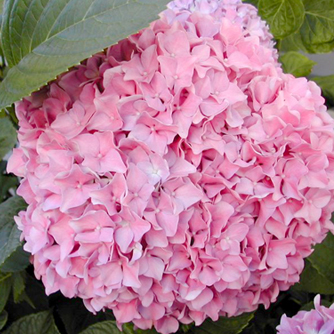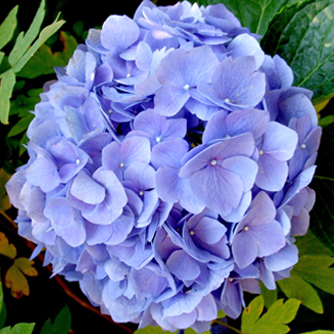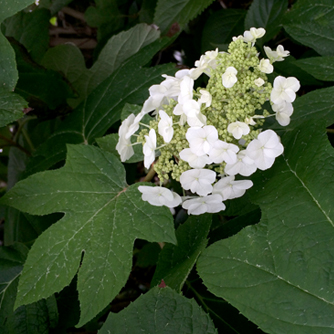Hydrangeas
BackHydrangeas are reliable shrubs which are suddenly no longer “Grandma plants” and are once again being appreciated for their charm and beauty. Part of this resurgence is due to the introduction of new varieties which are more compact in growth. Breeders have also produced a number of smaller growing varieties that are suitable for pots and courtyards. One thing is for sure, hydrangeas always put on a fantastic display every summer with their clusters of pink, blue or white blooms which are impossible to miss. Plus their large leaves give a lush feeling and liven up shady corners of the garden.
Flowers make excellent cut flowers or can be left on the bush where they remain attractive even as they age and fade. One of the unusual things about hydrangeas is that the colour of the flowers will change depending on the pH of the soil. If your soil pH is alkaline flowers will be pink but if your soil pH is acidic they will be blue. Strangely white flowers will stay white regardless of pH but then fade to either pink, blue or green.
You can use powdered sulphur, coffee grounds or organic matter to lower pH and produce blue flowers but it can be a slow process. To raise the pH and produce pink flowers use lime or dolomite which usually works faster.

Large pink hydrangea flowers
Main Types of Hydrangeas
Hydrangea macrophylla is the most common type of hydrangea and are often called ‘mopheads’ because flower heads are produced in large round balls. Shrubs range in size from dwarf to 2m x 2m. ‘Pia Mina’ is a dwarf variety (approximately 60cm high) that is excellent for pots and small gardens.
Lacecaps are a type of H. macrophylla that produce a distinctly different flower head. The centre of the bloom is filled with buds which don’t open and are surrounded by a single row of open flowers. Lacecaps tend to be more compact and flower from late Spring right through to summer.
Hydrangea quercifolia is a less common species known as the oak leaf hydrangea due to – yes you guessed it – its leaves resembling an oak leaf. The dense white flower heads are elongated with a double variety also being available. Grows around 2m high x 2m wide.
Hydrangea paniculata produces white pyramid or conical shaped flowers in Summer and has a lovely crinkly leaf. A pink form called Pink Diamond is also available. Grows 2m high x 3m wide and can take a bit more sun. Tends to perform better in areas with cooler winters.
Hydrangea petiolaris is one for avid gardener as it isn’t as easy to find. This climbing hydrangea produces flattened white flower heads of mostly tiny flowers interspersed with a few enlarged sterile flowers. It can grow up to 15m but you’ll need to be keen as it is very slow growing and reports are that it can take 10 years to flower!

Blue hydrangea flowers occur when plants grow in acidic soils
How To Grow Hydrangeas
Hydrangeas grow best in well drained but moist fertile soil. Add plenty of compost to the soil and if you’re planting into clay apply gypsum beforehand to improve the drainage. Whilst hydrangeas can be quite resilient plants it is important to remember they need part shade and shelter from strong hot winds. An easterly position is perfect, providing necessary shade in the afternoon to stop the plant from burning.
Ensure they get enough water throughout Spring and Summer as they quickly wilt if they dry out. Mulching around their roots helps as their root system is quite close to the surface of the soil. If you need to improve moisture retention around the plant apply OCP eco-hydrate every 3-4 weeks during hot weather.
Fertilising
All those large flowers and lush foliage require plenty of nutrients. Enrich the soil with compost, manures or an organic fertiliser 2-3 times a year. Boost this with a liquid feed of OCP eco-aminogro and OCP eco-seaweed every 2-3 weeks and your hydrangeas will love it.

White hydrangea flowers
Pruning
Pruning can be done any time from late Summer (after flowering has finished) right through to Winter. Cut stems which flowered back to a pair of plump double buds. Leave stems which didn’t flower alone. Remove any dead wood completely.
After pruning use the cuttings to propagate new plants as hydrangeas strike very easily from hardwood cuttings. Simply plant in a pot of free draining potting mix and keep slightly damp. New roots will form by Spring.
Pest and Disease Problems for Hydrangeas
Hydrangeas are relatively pest and disease free but watch out for:
- Mites - they can attack foliage but these can be controlled with OCP eco-oil or OCP eco-neem.
- Powdery mildew - this common fungal disease creates a light grey or white coating over foliage. Control by spraying with an organic fungicide.
- Scale - these sap suckers will sometimes attack and need to be treated with horticultural oil sprays.

Oak leaf hydrangea


